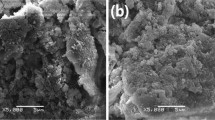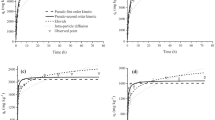Abstract
A series of carbonaceous biosorbents was prepared by pyrolyzing pine needles, a model biomass, at various temperatures (100–700°C) under an oxygen-limited condition for 6 h. The elemental compositions and the specific surface areas (BET-N2) of the biosorbents were analyzed. Sorption properties of 4-nitrotoluene to the biosorbents and their mechanisms were investigated, and then correlated with the structures of the biosorbents. The result shows that with the increase of the pyrolytic temperature, the aromaticity of the carbonaceous biosorbents increases dramatically and the polarity (the (N+O)/C atomic ratio) decreases sharply. Correspondingly, conformations of the organic matter in the biosorbents transform gradually from a “soft-state” to a “hard-state” and the specific surface areas of the resultant biosorbents extend rapidly. The sorption isotherms fit well with the Freundlich equation. The regression parameters (i.e., N and IgK f) are linearly related to the aromaticity indices (the H/C atomic ratio). Contributions of adsorption and partition to total sorption of the carbonaceous biosorbents are quantified. The adsorption of the carbonaceous biosorbents increases quickly with the increase of the pyrolytic temperature. The saturated adsorption amounts (Q max) increase linearly with the increase of the specific surface areas (SA) of the biosorbents. For the carbonaceous biosorbents with hard-state carbon, the calculated normalized-Q max values by SA are comparable to the theoretical estimation (2.45 μmol/m2). In comparison, for the carbonaceous sorbents with soft-state carbon, the calculated normalized-Q max values by SA are much higher than the theoretical estimation. The partition coefficients (K om) increase with the decrease of the polarity of the biosorbents, reaching a maximum, and then decrease sharply with further decreasing the polarity, suggesting that partition mechanism be dominated by the compatibility and accessibility of the sorbent medium with organic pollutant. These observations will provide a theoretical and practical reference to design a cost-effective and high-efficient sorbent, and to accurately predict sorption properties and mechanisms of a given sorbent.
Similar content being viewed by others
References
Zhu L Z, Chen B L, Wang J, Shen H X. Pollution survey of polycyclic aromatic hydrocarbons in surface water of Hangzhou, China. Chemosphere, 2004, 56(11): 1085–1095
Chen B L, Xuan X D, Zhu L Z, Wang J, Gao Y Z, Yang K, Shen X Y, Lou B F. Distributions of polycyclic aromatic hydrocarbons in surface waters, sediments and soils of Hangzhou city, China. Water Research, 2004, 38: 3558–3568
Zhu L Z, and Chen B L. Sorption behavior of p-nitrophenol on the interface between anion-cation organobentonite and water. Environ Sci Technol, 2000, 34: 2997–3002
Zhu L Z, Chen B L, Shen X Y. Sorption of phenol, p-nitrophenol, and aniline to dual-cation organobentonites from water. Environ Sci Technol, 2000, 34: 468–475
Ru J, Liu H J, Qu J H, Wang A M, Dai R H. Characterization and adsorption behavior of a novel triolein-embedded activated carbon composite adsorbent. Chin Sci Bull, 2005, 50(23): 2788–2790
Huo J X, Liu H J, Qu J H, Ru J, Liu H N, Li G T. Dieldrin and endrin removal from water by triolein-embedded adsorbent. Chin Sci Bull, 2005, 50(23): 2696–2700
Chiou C T. Partition and Adsorption of Organic Contaminants in Environmental Systems. Hoboken: John Wiley & Sons, Inc., 2002. 106–213
Weber W J Jr, McGinley P M, Katd L E. A distributed reactivity model for sorption by soils and sediments. 1. conceptual basis and equilibrium assessments. Environ Sci Technol, 1992, 26: 1955–1962
Xing B S, Pignatello J J. Dual-mode sorption of low-polarity compounds in glassy poly(vinyl chloride) and soil organic matter. Environ Sci Technol, 1997, 31: 792–799
Jacobson M Z. Strong radiative heating due to the mixing state of black carbon in atmospheric aerosols. Nature, 2001, 409: 695–697
Masiello C A, Druffel E R M. Black carbon in deep-sea sediments. Science, 1998, 280(19): 1911–1913
Schaefer A. Does supersorbent soot control PAH fate. Environ Sci Technol, 2001, 35(1): 10 A
Bucheli T D, Gustafsson Ö. Quantification of the soot-water distribution coefficient of PAHs provides mechanistic basis for enhanced sorption observations. Environ Sci Technol, 2000, 34(23): 5144–5151
Chun Y, Sheng G Y, Chiou C T, Xing B S. Compositions and sorptive properties of crop residue-derived chars. Environ Sci Technol, 2004, 38(17): 4649–4655
Pappa A, Tzamtzis N, Statheropoulos M, Fasseas C. The pyrolytic behavior of Pinus halepensis needles observed by transmission light microscopy and stereoscopy. J Anal Appl Pyrolysis, 2000, 55: 195–202
Chen B L, Johnson E J, Chefetz B, Zhu L Z, Xing B S. Sorption of polar and nonpolar aromatic organic contaminants by plant cuticular materials: the role of polarity and accessibility. Environ Sci Technol, 2005, 39: 6138–6146
Gunasekara A S, Simpson M J, Xing B S. Identification and characterization of sorption domains in soil organic matter using structurally modified humic acids. Environ Sci Technol, 2003, 37: 852–858
Chiou C T, Peters L J, Freed V H. A physical concept of soil-water equilibria for nonionic organic compounds. Science, 1979, 205: 831–832
Nguyen T H, Cho H H, Poster D L, Ball W P. Evidence for a pore-filling mechanism in the adsorption of aromatic hydrocarbons to a natural wood char. Environ Sci Technol, 2007, 41: 1212–1217
Chen B L, Xing B S. Sorption and conformational characteristics of reconstituted plant cuticular waxes on montmorillonite. Environ Sci Technol, 2005, 39: 8315–8323
Author information
Authors and Affiliations
Corresponding author
Additional information
Supported by the National Natural Science Foundation of China (Grant No. 20577041), and the Program for New Century Excellent Talents in University (Grant No. NCET-05-0525)
Rights and permissions
About this article
Cite this article
Chen, B., Zhou, D., Zhu, L. et al. Sorption characteristics and mechanisms of organic contaminant to carbonaceous biosorbents in aqueous solution. Sci. China Ser. B-Chem. 51, 464–472 (2008). https://doi.org/10.1007/s11426-008-0041-4
Received:
Accepted:
Published:
Issue Date:
DOI: https://doi.org/10.1007/s11426-008-0041-4




